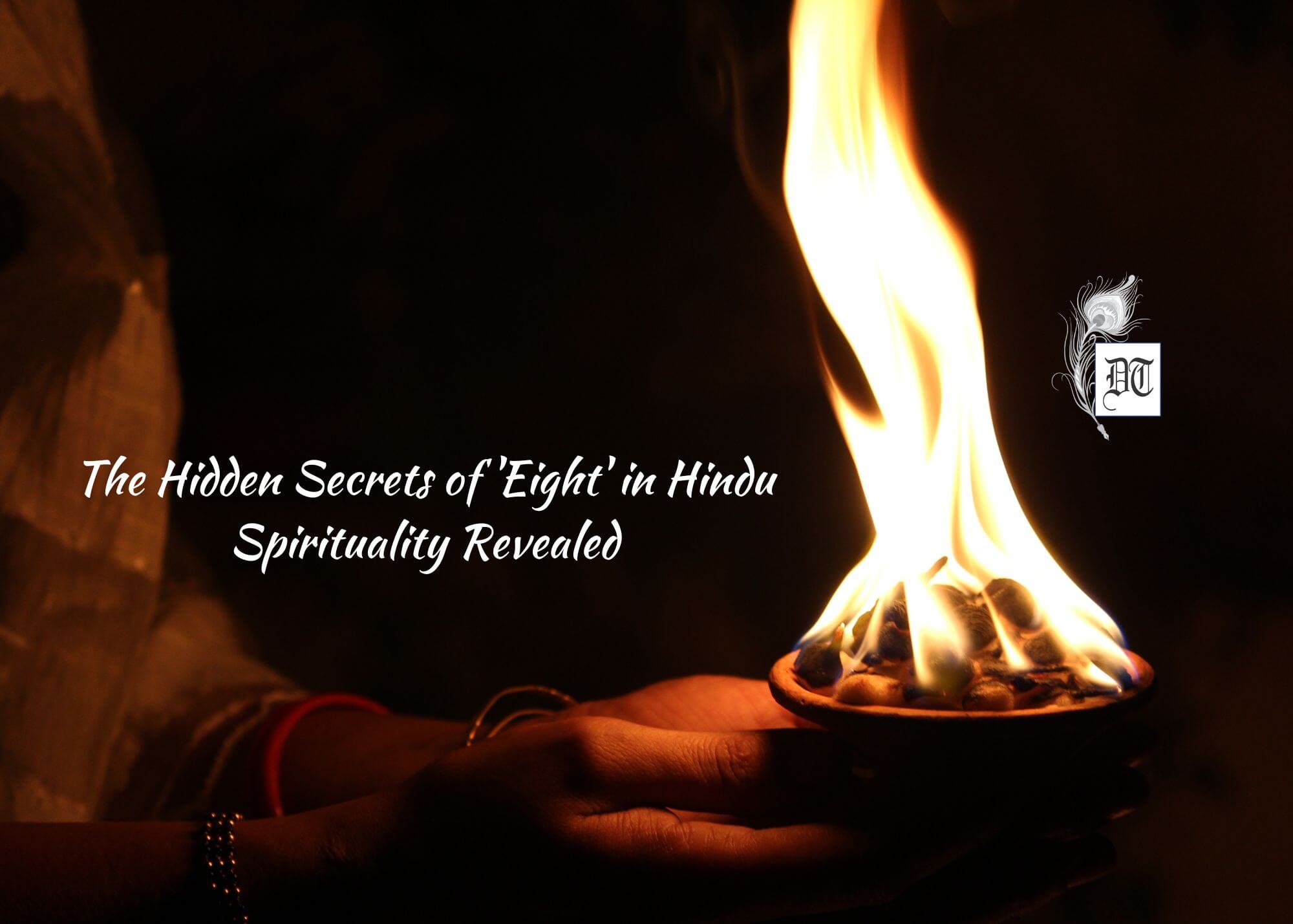Ashta, the eighth number in Sanatan Dharma holds significant spiritual and cosmic connections in Hindu mythology with its powerful symbolic significance, elucidating Rajul, exclusively for Different Truths.

In Sanatan Dharma, numbers hold profound symbolic significance. Each number is associated with unique meanings and symbolism, and none is more enigmatic and powerful than the number eight. The number eight, or “Ashta” in Sanskrit, has a rich and mysterious history within the Hindu tradition. It appears in various forms, representing various concepts, deities, and cosmic forces. Let’s explore the profound mysteries and symbolism surrounding the number eight in Hindu mythology, unveiling its deep spiritual and cosmic connections.
1. Ashta, the Foundation of the Universe
In Hinduism, the number eight is often linked to the creation and foundation of the universe. The sacred text, the Mandukya Upanishad, introduces the concept of “Ashta Prakriti,” meaning the eightfold nature of the universe. This eightfold nature consists of Prakriti (the primordial matter) and its seven transformations, which are Buddhi (intellect), Ahamkara (ego), Manas (mind), Pancha Tanmatras (five subtle elements), and Pancha Mahabhutas (five gross elements). This framework signifies the interconnectedness and unity of the cosmos, with the number eight acting as the underlying structure upon which the universe is built.
Number eight is also associated with Saturn or Shani graha. Shani is the actual karma-phal-data (giver of the fruits of our karma) and hence moves slowly and steadily. It relates to all aspects of our lives, and justice is served not only in this lifetime but across lifetimes in a soul’s journey. If you are number eight, you can shape and reshape your life with your karma. You can make your future with your hands; all that is required is willingness and hard work in the right direction.
2. The Eight Directions
The number eight is intricately linked to the cardinal and intercardinal directions in Hindu cosmology. Eight guardian deities who oversee and control the universe preside over these eight directions, also known as the “Ashta Dikpalas.” These deities are Indra (East), Agni (Southeast), Yama (South), Nirriti (Southwest), Varuna (West), Vayu (Northwest), Kubera (North), and Ishana (Northeast). The number eight represents the all-encompassing nature of these directions and their influence on various aspects of life.
3. Ashta Siddhis and Ashta Lakshmis
In Hinduism, the number eight is associated with various divine boons and blessings. The “Ashta Siddhis” represent the eight supernatural powers or accomplishments that one can attain through spiritual practice. These Siddhis include Anima (ability to become tiny), Mahima (ability to become vast), Garima (ability to become heavy), Laghima (ability to become light), Prapti (ability to acquire anything), Prakamya (fulfilment of desires), Ishitva (supreme lordship), and Vashitva (control over others). These Siddhis are considered divine gifts linked to spiritual enlightenment and the realisation of the self.
Similarly, the number eight is associated with the “Ashta Lakshmis,” representing eight forms of the Goddess Lakshmi, the deity of wealth, fortune, and abundance. These forms are Adi Lakshmi (the primal form), Dhana Lakshmi (wealth and prosperity), Dhanya Lakshmi (agricultural wealth), Gaja Lakshmi (wealth from elephants), Santana Lakshmi (wealth of progeny), Veera Lakshmi (courage and strength), Vijaya Lakshmi (victory and success), and Aishwarya Lakshmi (wealth of splendour). The symbolism of these eight aspects of Lakshmi signifies the multifaceted nature of prosperity and abundance.
4. The Eightfold Path
The number eight is also central to the spiritual teachings of Hinduism. The sage Patanjali described the “Ashtanga Yoga,” or the eightfold path, in the Yoga Sutras, which serves as a fundamental roadmap for spiritual growth and self-realisation. This eightfold path consists of Yama (moral restraints), Niyama (observances), Asana (physical postures), Pranayama (breath control), Pratyahara (sense withdrawal), Dharana (concentration), Dhyana (meditation), and Samadhi (self-realisation). The number eight in this context signifies the stages of personal transformation and enlightenment, leading individuals toward a state of union with the divine.
5. The Octagonal Shape and Temples
The octagonal shape, associated with the number eight, is often found in Hindu temple architecture. Many Hindu temples are constructed with an octagonal layout or feature octagonal elements, such as spires or walls. This design represents the cosmic order and the harmonious integration of the material and spiritual worlds. The octagonal shape is also believed to create a conducive environment for meditation and worship, as it symbolises the interconnectedness of all aspects of existence.
6. Navadurga and Her Ashta Matrikas
The number eight plays a significant role in the worship of the goddess Durga. In the Navaratri festival, dedicated to the worship of the Divine Mother, the Goddess is venerated in her nine forms, representing the nine nights of the festival. The eighth night is dedicated to Mahagauri, one of Durga’s manifestations. This aspect of Durga symbolises purity and spirituality. Additionally, Durga is often associated with her “Ashta Matrikas,” a group of eight warrior goddesses who are considered her companions. These Ashta Matrikas are Brahmani, Maheshwari, Kaumari, Vaishnavi, Varahi, Indrani, Chamunda, and Narasimhi. They are worshipped for protection and the eradication of evil forces.
7. The Number Eight in Rituals and Offerings
The number eight features prominently in Hindu rituals and offerings. In various religious ceremonies, offerings are often made in sets of eight, symbolising abundance, balance, and cosmic order. For example, eight lamps are commonly lit, and eight flowers or fruits are offered to deities during worship. The significance of this number in rituals is a reminder of the divine presence and the completeness of the offering.
8. The Vedic Perspective
In Vedic cosmology, the number eight is also deeply revered. It is associated with the “Ashtaveda,” which refers to the eight branches of knowledge within the Vedas. These branches include Rigveda, Yajurveda, Samaveda, Atharvaveda, Siksha (phonetics), Kalpa (rituals), Vyakarana (grammar), and Nirukta (etymology). The Ashtaveda represents the comprehensive nature of Vedic knowledge, encompassing various facets of life and spirituality.
The number eight in Hindu mythology is not just a numerical symbol; it is a profound and intricate aspect of the Hindu belief system. It represents cosmic order, divine blessings, spiritual paths, and the multifaceted nature of the universe. The mysteries and symbolism surrounding the number eight are a testament to the richness and depth of Hindu mythology, where even the simplest of elements can hold profound spiritual significance. In understanding the number eight, we gain insight into the interconnectedness of the material and spiritual realms, and we find a profound reverence for the divine in every aspect of life.
Picture design by Anumita Roy





 By
By

 By
By
 By
By